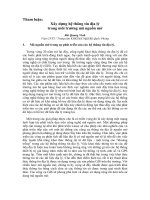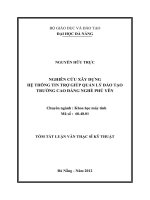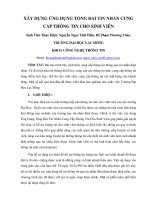The Traditional Approach to Design (XÂY DỰNG ỨNG DỤNG HỆ THỐNG THÔNG TIN SLIDE)
Bạn đang xem bản rút gọn của tài liệu. Xem và tải ngay bản đầy đủ của tài liệu tại đây (831.55 KB, 35 trang )
10
Chapter 10:
The Traditional
Approach to Design
Systems Analysis and Design in a Changing
World, 3rd Edition
10
Learning Objectives
◆
Develop a system flowchart
◆
Develop a structure chart using transaction
analysis and transform analysis
◆
Write pseudocode for structured modules
Systems Analysis and Design in a Changing World, 3rd Edition
2
10
Overview
◆
Traditional approach to designing software
●
Overview of structured models, model
development process, related terminology
●
How data flow diagrams are annotated with
automation boundary information
●
How analysis phase models are transformed into
design models using system flowcharts, structure
charts, and module pseudocode
●
Integration into other design phase activities
●
Applying approach to a three-layer architecture
Systems Analysis and Design in a Changing World, 3rd Edition
3
The Structured Approach to Designing
the Application Architecture
◆
10
Application software programs
●
Designed in conjunction with database and user
interface
●
Hierarchy of modules
◆
Design internal logic of individual modules
◆
Top-down approach
●
DFDs with automation boundaries
●
System flowcharts, structure charts, pseudocode
Systems Analysis and Design in a Changing World, 3rd Edition
4
10
Structured Design Models
Systems Analysis and Design in a Changing World, 3rd Edition
5
10
The Automation System Boundary
◆
Partitions data flow diagram processes into
manual processes and automated systems
◆
Processes can be inside or outside boundary
◆
Data flows can be inside and outside of boundary
●
Data flows that cross system boundary represent
inputs and outputs of system
●
Data flows that cross boundaries between
programs represent program-to-program
communication
Systems Analysis and Design in a Changing World, 3rd Edition
6
10
DFD with Automation System Boundary
Systems Analysis and Design in a Changing World, 3rd Edition
7
10
The System Flowchart
◆
Representation of various computer programs,
files, databases, and associated manual
processes that make up complete system
◆
Frequently constructed during analysis activities
◆
Graphically describes organization of subsystems
into automated and manual components
◆
Can show type of transaction processing system
●
Batch
●
Real time
Systems Analysis and Design in a Changing World, 3rd Edition
8
10
Common System Flowchart Symbols
Systems Analysis and Design in a Changing World, 3rd Edition
9
Sample System Flowchart
for Payroll System
Systems Analysis and Design in a Changing World, 3rd Edition
10
10
10
System Flowchart for RMO
Systems Analysis and Design in a Changing World, 3rd Edition
11
10
The Structure Chart
◆
Describes functions and subfunctions of each part
of system
◆
Shows relationships between modules of a
computer program
◆
Simple and direct organization
◆
●
Each module performs a specific function
●
Each layer in a program performs specific activities
Chart is tree-like with root module and branches
Systems Analysis and Design in a Changing World, 3rd Edition
12
A Simple Structure Chart for the
Calculate Pay Amounts Module
Systems Analysis and Design in a Changing World, 3rd Edition
10
13
10
Structure Chart Symbols
Systems Analysis and Design in a Changing World, 3rd Edition
14
10
Structure Chart for Entire Payroll Program
Systems Analysis and Design in a Changing World, 3rd Edition
15
10
Developing a Structure Chart
◆
◆
Transaction Analysis
●
Uses system flow chart and event table inputs
●
Upper-level modules developed first
●
Identifies each transaction supported by program
Transform Analysis
●
Uses DFD fragments for inputs
●
Computer program ‘transforms’ inputs into outputs
●
Charts have input, calculate, and output subtrees
Systems Analysis and Design in a Changing World, 3rd Edition
16
Event-partitioned DFD for the Order-Entry
Subsystem
Systems Analysis and Design in a Changing World, 3rd Edition
10
17
High-level Structure Chart for the
Customer Order Program
Systems Analysis and Design in a Changing World, 3rd Edition
10
18
Steps to Create a Structure Chart
from a DFD Fragment
◆
10
Determine primary information flow
●
Main stream of data transformed from some input
form to output form
◆
Find process that represents most fundamental
change from input to output
◆
Redraw DFD with inputs to left and outputs to
right – central transform process goes in middle
◆
Generate first draft structure chart based on
redrawn data flow
Systems Analysis and Design in a Changing World, 3rd Edition
19
10
The Create New Order DFD Fragment
Systems Analysis and Design in a Changing World, 3rd Edition
20
10
Exploded View of Create New Order DFD
Systems Analysis and Design in a Changing World, 3rd Edition
21
10
Rearranged Create New Order DFD
Systems Analysis and Design in a Changing World, 3rd Edition
22
10
First Draft of the Structure Chart
Systems Analysis and Design in a Changing World, 3rd Edition
23
Steps to Create a Structure Chart from a
DFD Fragment (continued)
◆
10
Add other modules
●
Get input data via user-interface screens
●
Read from and write to data storage
●
Write output data or reports
◆
Add logic from structured English or decision
tables
◆
Make final refinements to structure chart based
on quality control concepts
Systems Analysis and Design in a Changing World, 3rd Edition
24
The Structure Chart for the Create New
Order Program
Systems Analysis and Design in a Changing World, 3rd Edition
10
25







![[Khóa luận]thiết kế và xây dựng hệ thống tín hiệu đèn giao thông nút giao thông lê hồng phong và nguyễn bỉnh khiêm dùng PLC](https://media.store123doc.com/images/document/13/ce/jj/medium_iEXM7MKsu1.jpg)

